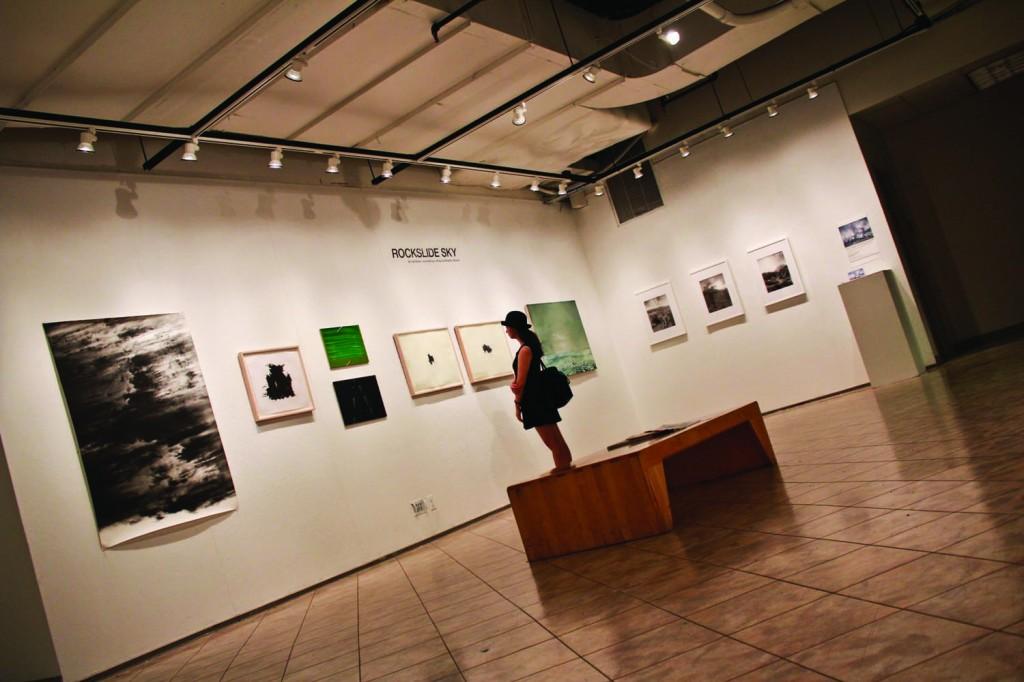Rockslide Sky: A Visual Collaboration With Literature
Fordham Visual Arts Exhibition Takes Inspiration from Short Story
Works from “Rockslide Sky” hang in both the Center Gallery and Lipani Gallery at FCLC from now until Nov. 5. (Weiyu LI/The Observer)
October 17, 2012

“Rockslide Sky,” the new art exhibition at Fordham College at Lincoln Center (FCLC) can be best described as a visual collaboration of the work of Roberto Bolaño, the late Chilean writer who penned novels such as “2666,” along with award-winning short stories and essays. The exhibit—located in the Center Gallery and Lipani Gallery at FCLC—is a response to Bolaño’s story “Gomez Palacio,” a short piece named after the bleak and desolate town in which it is set.
Upon entering, Jared Handelsman’s “Speeding Down Hearts Content Road at Midnight” immediately catches the eye, a large black-and-white photogram that looks like an ominous representation of the night sky. The piece perfectly captures Bolaño’s depiction of the “gray wall” that night brings upon Gomez Palacio—it is foreboding and yet inviting, darkness you cannot look away from.
Photograms are photographic images made without a camera, using photosensitive paper and exposing it to light. Handelsman, who operates with partner Portia Munson out of an 83-acre plot of land in the Catskills, has been making photograms since the ’90s, using his grand expanse of land as inspiration. He will wait in a field for hours—dealing with ticks and prowling coyotes—in order to capture the perfect moment, headlights coming around a bend or light breaking through clouds.
Another piece, by Morgan O’Hara, at first glance appears to be a Rorschach inkblot test. O’Hara refers to the work as “Live Transmissions,” representations of live performances rendered on the page. According to her website, “The Live Transmission drawings are a record, performed in real time, of the vital movement of living beings. They transcend both figuration and abstraction.” The piece is purposefully ambiguous, much like the story itself.
The story—published posthumously in The New Yorker in 2005—revolves around an unhappy young writer that is sent to “some godforsaken town in northern Mexico” to help run a writing workshop. It is in Gomez Palacio where he meets the director of the program, a woman he describes as “plump, middle aged… with bulging eyes, wearing a large dress.” Every day, the director would drive him—in silence—to and from the workshop, where the students underwhelm him with their creativity and where he struggles to sleep, anxiously locking and relocking the doors and windows through the night.
Carleen Sheehan, curator of the exhibit and a visual arts professor at Fordham, was drawn to this particular aspect of story. “What’s interesting to me,” she said, “are the chance encounters and little moments of beauty. It’s about chance and coincidence.”
Sheehan first discovered the story nearly two years ago, shortly before attending a gallery hosted by friend and artist Tom McGrath. She was immediately struck by the similarities in the work, not only in the use of color and form, but in the feelings that each evoked. His piece in the exhibit, entitled “Where You Stand,” is centered on green shrubbery, a chain-link fence, and what appear to be headlights in the unfocused background.
After reading the story, these types of encounters became a pattern for Sheehan. While visiting exhibits of friends and peers she was constantly reminded of Bolaño’s work.
“The artwork is all very different, very unique,” Sheehan said. “Each artist has a distinct style, and even distinct mediums, but they are tied together through this story. I thought that was an interesting idea.”
In this sense, the selection of pieces in the exhibit reflects the random nature of the story itself. While Sheehan admits that some of the works may have to be explained, they should all convey a similar emotion. Bolaño describes a world in which mundane things create beauty, where emptiness is reassuring, and where mysteries should be left as just that—mysterious.
The exhibit runs through Nov. 5.












